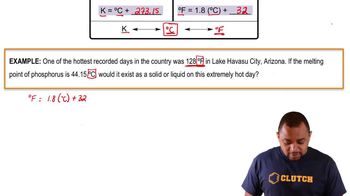Here are the essential concepts you must grasp in order to answer the question correctly.
Ideal Gas Law
The Ideal Gas Law is a fundamental equation in chemistry that relates the pressure, volume, temperature, and number of moles of a gas. It is expressed as PV = nRT, where P is pressure, V is volume, n is the number of moles, R is the ideal gas constant, and T is temperature in Kelvin. This law allows us to calculate the pressure of a gas when the other variables are known.
Recommended video:
Molar Mass
Molar mass is the mass of one mole of a substance, typically expressed in grams per mole (g/mol). For methane (CH4), the molar mass is approximately 16.04 g/mol, calculated from the atomic masses of carbon and hydrogen. Knowing the molar mass is essential for converting the mass of a substance into moles, which is necessary for applying the Ideal Gas Law.
Recommended video:
Temperature Conversion
In gas law calculations, temperature must be expressed in Kelvin rather than Celsius. The conversion from Celsius to Kelvin is done by adding 273.15 to the Celsius temperature. For example, 20 °C is equivalent to 293.15 K. This conversion is crucial because the Ideal Gas Law requires absolute temperature for accurate calculations.
Recommended video:
Temperature Conversion Example
 Verified step by step guidance
Verified step by step guidance

